Charles Marion Russell’s “Indian Women Moving Camp” – Study & Analysis
by David Fox
This visual analysis will be on the water color painting called, “Indian Women Moving Camp” done by Charles Marion Russell in 1898.
I was researching 20th century American artists, when I came upon C.M. Russell. Right away, I was intrigued. It was the first time that I had come upon the “Wild West” theme and the many cowboy and Indian paintings.
Cowboys and Indians had not touched my life since I was five years old. My playmates and I explored conflict in a game called, “Cowboys and Indians”, at my infant school in London, England.
Back then, it was all about the “good guys” such as Roy Rogers and Tex Ritter, versus the “bad” Indians. I never wanted to play the part of an Indian as they always lost the battle.
I will always remember this show, “High Noon”, as it captured the “cowboy” way so perfectly to me. Cowboys to me were like idols, heroes…
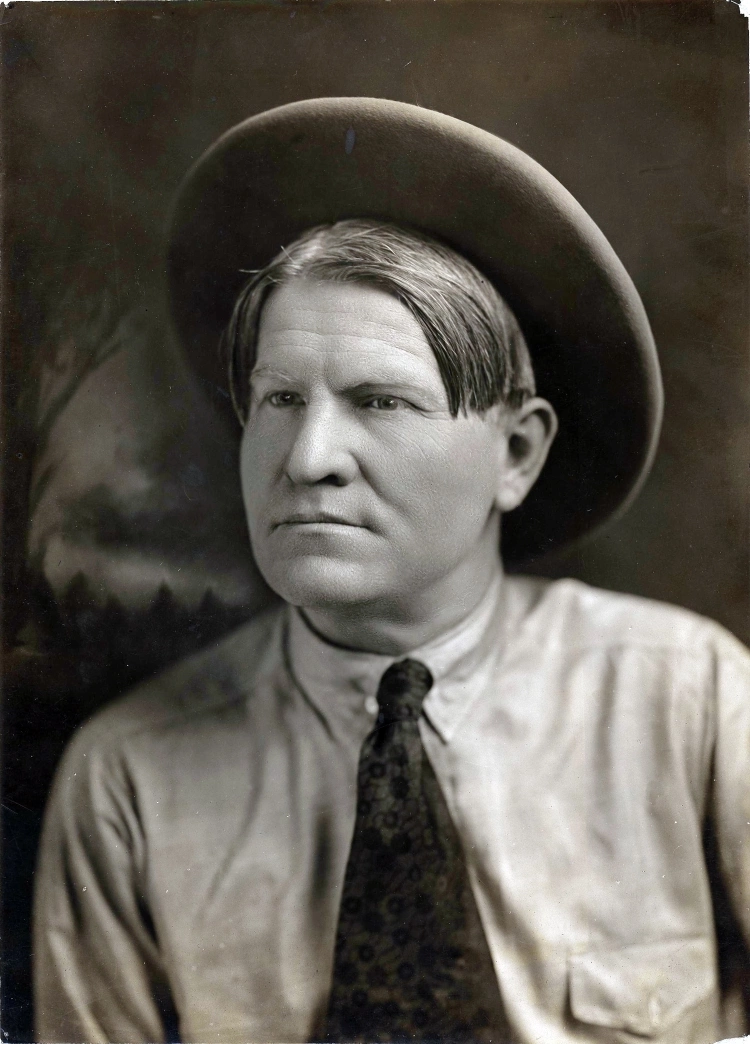
Charles Marion Russell
At a young age, Charles Marion Russell loved to sketch and model animals in clay. After learning at an early age, that he was interested in art such as drawing, painting and sculpting as I was, my interest in him grew quickly.
He was born in Oakhill Montana in 1864, and loved everything about life in the West. He left school at 16 and so did I. Russell went on to be an internationally acclaimed American artist, known for his passionate art of Indian life west of the Mississippi in the USA.
He painted over 4,000 pieces of art, highlighting the Native American culture and nature in general.
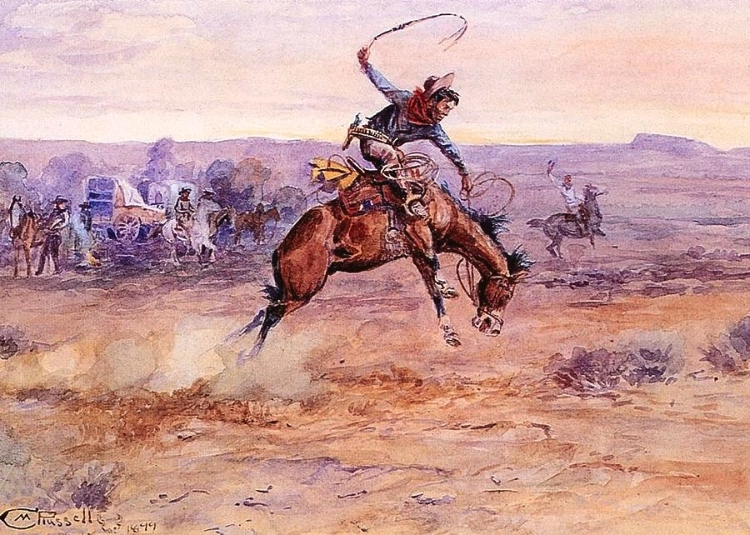
He also sculpted in wax, plaster, and bronze. I worked in the field of “tool and die,” which demanded many creative problem solving skills, which I loved to do very much. I didn’t begin to take painting seriously until about 5 years ago.
I looked at many of Russell’s paintings, but kept returning to “Indian Women Moving Camp”. I was drawn immediately to the woman on horseback in the centre of the painting.
To me, she represented the difficult life that the women at that time in history were experiencing, not only Native women but all women. The White Women’s Suffrage Movement began to take shape in America in the 1840’s, and it wasn’t until 1920 when white women could vote nationally in the USA.
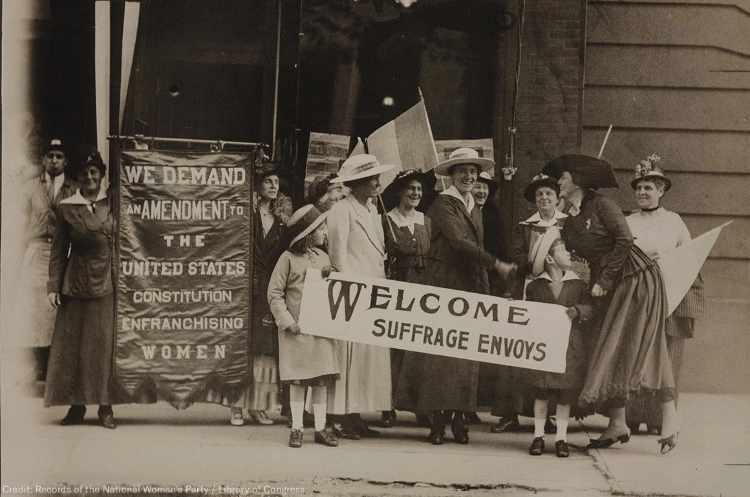
This native American woman in the painting, was looking ahead to where she had to go. She looked tired, and so did the horse she was riding. She possibly knew that the White settlers were behind her and they wanted her land, or maybe she was just following the buffalo.
The Indians were being pushed farther and farther west and north by the White man. I could identify with her stress because of what I witnessed my mother go through, and what happened in my life because of the decisions my mother made.
I would speculate that the theme of this painting was much more specific than what the life of the Native Americans was like.in western USA at the turn of the 20th century.
The theme of this particular Russell painting could be “The Role of Native American Women in the Wild West in the early 1900’s.” Native American women had a complicated and difficult life during the time Russell was alive (1864 – 1926).
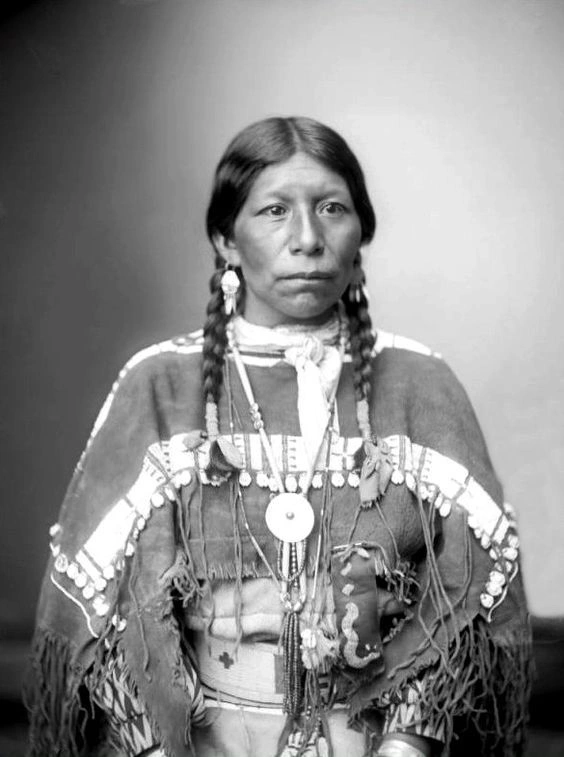
Ever since I began painting, I tried to communicate through my work what experiences I have had that had the most impact on me. My early years as a child and teenager back in England were a struggle for myself and my mother.
I was now very interested in this painting and I wanted to know all about it and the history of it.
The narrative in the “Indian Women Moving Camp”, began to unfold for me quickly, and I began to identify with its messages. I too had to travel away from my home and family and come to Canada in search of better times.
I moved many times just as the Plains Indians would have done. Their environment, food sources, and the demands of the white settlers, determined where they would live. Nature around them, such as the bullrushes, seemed just as stressed as the horses and the people.
The characters in the painting stopped for a well needed drink from the small pond, which seems to be the focal point of the painting since Russell situated the water in the centre of the picture.
Russell was determined to tell the story of the Native American Indians because life in the “Old West” meant so much to him.
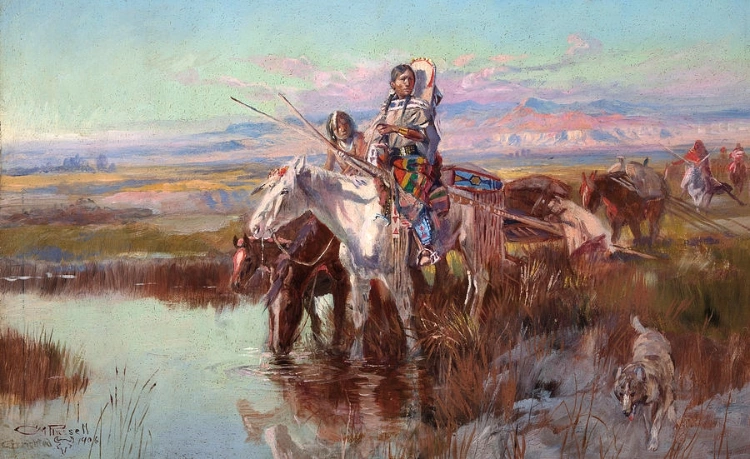
Russell made the woman in his composition the most important character. I felt that she represented power, determination, and resourcefulness.
She was on a white horse and in the centre of the painting and Russell painted her as the biggest object in the composition. Her body position suggested that she was in charge.
This “alpha” female needed to lead her tribe to safety. Russell used a diagonal movement across the paper, which could indicate the long distance these people had to travel to find a new life. The lead Indian woman is loaded up with all her worldly belongings.
Not only was the travois behind the horse, full, but the squaw had a child strapped on her back. In the painting, on her left, was a brave guarding her and the women following, whilst on her right, a large camp dog was also on guard.
The main female character displayed power and control over the situation, which Russell wanted to include in the painting, because after living with the Plains Indians for a time, he understood completely the hierarchy of the roles within the Indian family and tribe.
This main female character was looking up and away, trying to predict the future, while the animals and other people were looking down, indicates their struggle and their submissive position within the group.
She was in charge! Was she waiting for the rest of the tribe to catch up to her? It looked as if she was contemplating her next move. Should the group stop and camp because they did have a water source, or should they move on?
All of this reminded me once again of the strong personality of my mother. It took much strength on my mother’s part to send me off to Canada alone. She also made difficult decisions.
1898 was a time when the Native American Indians were very popular because they occupied much of the valuable land west of the Mississsippi that the white settlers needed.
The Indians were the caregivers of thousands of acres of land in America, and in many parts of the world, there were arguments over land ownership, such as in Europe and in the Caribbean (Cuba).
American leaders at the time knew that the Indians were in the way of their progress. The American government had plans to do something about these Native peoples. World war was looming. The Plains Indians had struggled with the “White Man” for years over land, and Charles M. Russell was completely dedicated to America’s first peoples and he wanted to tell their story in his paintings. “Indian Women Moving Camp” was a perfect example of this American cultural conflict and C.M.
Russell was the man to share that with the world.
Russell personified Western America between 1864 and 1926. He wasn’t interested in the modernism movement at the time or even what might happen in the world of art in the future.
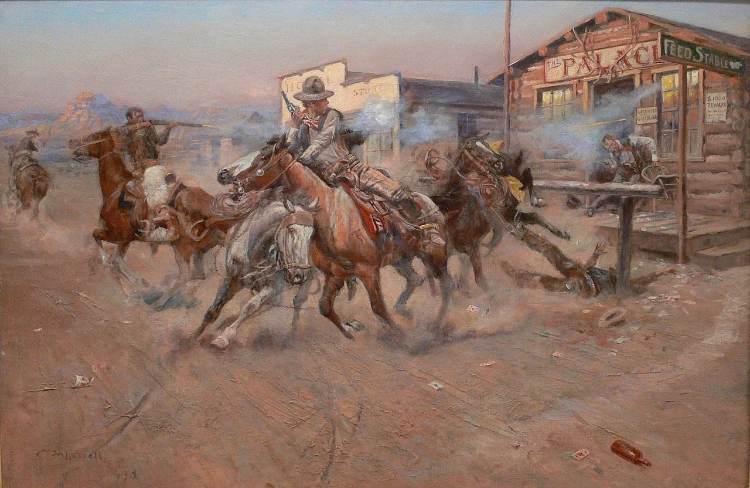
He was all about the past, and was passionate in everything that he did to represent the “Old West”. He painted nature and animals, especially horses.
He was lucky enough to have a log cabin studio as part of his home in Great Falls Montana. He and his wife, Nancy, built it. His wife was very supportive of his work, and became the person who marketed his talents. She did very well at that.
Nancy arranged for art shows for her husband in the US and in London England. Charles even used her to model for some of his paintings that required a female character.
Maybe he used her because it was convenient for him, or maybe, it was her ‘take charge’ personality that made her the best choice to represent Native American women.
Russell painted over 4000 paintings. He also sculpted, told stories, and wrote books for kids. He even wrote a screen play for a movie. His paintings were filled with action and movement.
Russell knew that he had many valuable skills, but his place in the West and his friendships with the people, were most important to him. He was completely dedicated to preserving the culture of the Indians in the West.
He was born in the West, worked in the West, lived with the Natives, and studied everything about the West that he could. He was always close to the Native People’s. Charles M. Russell spent most of his life in Montana and was talked about as a regional painter because his subject matter was so focused, precise and predictable.
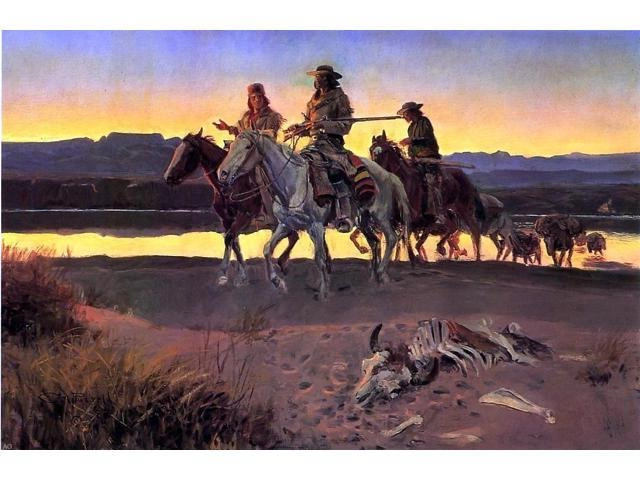
The schools in his home town of Great Falls Montana were even closed on the day of his funeral, so that the students could appreciate the town’s very well known artist.
Some would say that his work put him into the Pre-Raphaelite Brotherhood movement started in England, which was founded in 1848 by William Hunt.
The intentions of this group were to reform art by rejecting its mechanics. They were not for anything conventional or common place, which one might argue that Russell was about just that.
However, Russell fits in with the “PRB” because he interpreted the Western environment with intense colors, abundant details, and complex compositions.
Nature was very important to him. He was very serious about his work and appeared to be a believer in the style of painters in Europe between the early Renaissance (1400) up to the work of Raphael (1479).
The early Renaissance was the beginning of a time of great creative and intellectual activity.
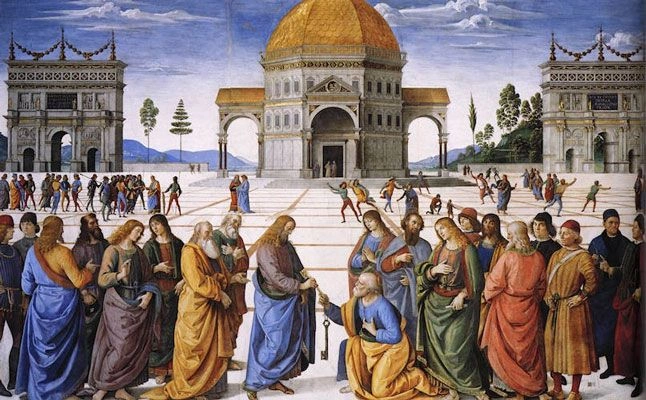
Artists broke away from the restrictions of Byzantine Art. The artists of this period studied the natural world in order to perfect their understanding of such subjects as nature, anatomy and perspective.
Even though Russell lived hundreds of years later, whether he knew it or not, his work and his passions seem to fit into the style of the Pre-Raphaelite group.
In spite of the great marketing skills of his wife, and the extensive experiences Russell had with the Native Peoples and the Old West, success in the art world needed luck, and Charles M. Russell believed in luck. But he was also very fluent in the elements of art such as color, form, texture and line. Russell painted the “Indian Woman Moving Camp”, theme more than once.
This particular painting was done with watercolors on paper. The painting was rendered in about 1896. Russell’s use of white for the main horse, which seemed to suggest that the rider was an “Alpha” female, who was strong and majestic.
Notice her head tilting upward. His use of a diagonal perspective moving the viewer’s eye from the centre of the painting to the extreme edges of the paper was also done on purpose.
Russell doesn’t want his audience to miss any details. Every detail and brush stroke plays an important role in telling his story.
The Indian band accompanying the female rider on the white horse appeared to be straggling behind in the distance, and most of them looked like females. They have come a long way and their journey wasn’t over yet.
Russell showed the vastness of the red plains by painting flat top mountains in the distance with little detail. In 1887-1888, Russell lived with the Blood Indians, another Plains group near the Canadian border.
There he learned about their use of the travois as a means of moving belongings from place to place. The transportation tool was made from teepee poles. Teepees were their traditional house dwellings.
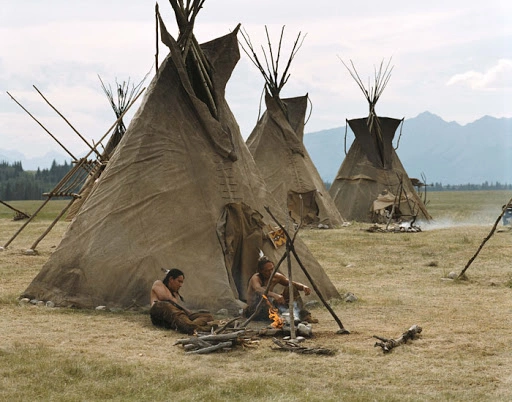
The travois was simple and served also as another vehicle for carrying children and the sick. When horses were introduced to the Indians by the Spanish in 1540, they stopped using dogs for their travois.
The Indian figures in this painting were carefully placed on the paper by Russell. With little detail around the animals and people, the viewer can’t help but pay close attention to what the characters are doing and possibly how they are feeling at this time and in this space.
Russell taught himself how to create pictures, and his work always took us back in time which appeared to be much simpler at first glance.
Russell’s use of light and color was subtle but vibrant, and he effectively created an atmosphere that made the audience feel hope for the Indians’ way of life.
His use of pastel mauves and delicate reds and browns, exuded a softness that seemed to make the viewer fall in love with the Indian. As the viewer’s glance followed the action into the background, the soft light seemed to blur the details.
It was very clever of Russell to use lines that make the positive spaces seem very realistic, especially in the foreground where he painted water.
Water was an important spiritual necessity for the Plains Indian and Russell was well aware of it.
After studying Charles M. Russell and his painting, “Indian Women Moving Camp”, I have been continually reminded of my own journey and goals in life.
I wanted a family and a secure, well paying job which challenged me creatively. My epic journey from England to Canada back in November 1968 was very similar to the Indian woman on the white horse in Russell’s watercolor.
We both wanted a good life and tried to move ahead to a better place. I was apprehensive about my journey across the Atlantic as she must have found it very difficult to find a new settlement in the wide open America West.
When I arrived at Toronto International Airport that day back in the 60’s, my life was full of unknowns. I too, had a family back in England and I was trying to be responsible for them.
The only difference between myself and the Indians in the painting was that they were a nomadic tribe and were use to traveling periodically, in search of a better life. I was not.
Leaving my home and moving to America, Canada to be exact, overwhelmed me. It was scary for me and I am sure it was for the Indian families as well.
Charles M. Russell did a great job at communicating all these emotions for his audience because he knew his subject so well. I spoke with the curator of the CM Russell Museum Complex in Great Falls Montana.
She told me that this painting was one of about six paintings that Russell painted on this particular topic. The curator was not sure where this watercolour painting was at the moment.
I did discover that this painting is located at The Buffalo Bill Center of the West in Cody Wyoming, formerly known as the Buffalo Bill Historical Center. Within this complex of five museums, Russell’s watercolour of “Indian Women Moving Camp” is located in the Whitney Gallery of Western Art.
Russell’s watercolour painting, “Indian Women Moving Camp” had a composition and visual harmony with nature. It was framed in the rectangular landscape format. In a portrait style painting, the short side of the painting is across the top.
This was a landscape style, which meant that the short side was up and down. The “thirds rule”, comes into play here also.
Artists used this clever placement of important objects in their compositions to create interest, tension and energy, and to avoid putting the most important part of the picture in the middle of the page.
The sky and the horizon were placed in the top one third of the painting, with the story in the bottom two thirds. The focus of the story was where the vertical and horizontal lines intersect right where they should in the middle of the painting.
The secondary parts of the painting’s story were around the central figures. The dog was in the immediate foreground, and the pond and the rest of the Indians were in the background closer to the horizon.
Russell certainly knew how to create impact. Everything about the painting suggested that life on the Plains in Western America. was very harsh in the late 19th and early 20th century.
I began this assignment knowing nothing about the American Wild West and I had no experience with paintings depicting the life of Native Americans. I had never heard of Charles M.
Russell. Now, I would love to see more works by Charles M. Russell. Hopefully I will soon have the opportunity to visit his museum in Great Falls, Montana. Most of all, I would like to experience, the watercolour painting, “Indian Women Moving Camp”, in person.
I know it would be much more vibrant and beautiful seeing it in real time. We have an international art gallery in Toronto and one in Ottawa, Canada.
I will check with them to see if they have any Russell paintings or whether they have plans in the future to show something by him. I personally want to thank Charles M.
Russell for the American history lesson. My critique of this painting has taught me so much.
Russell was totally immersed in his art at the time, and was certainly very aware of what was going on in the western part of America. He did not want things to change, but the pioneers were changing everything.
Russell was quoted as saying, “A Pioneer destroys things and calls it civilization.” This seems to suggest that Russell believed that the Pioneers’ changes were not for the best. I respect passionate people.
Russell demonstrated that he knew how much work and dedication that took to be successful and passionate.
Charles Marion Russell was a stage driver, a cattle ranger, a horse wrangler and a multi-disciplinary artist. He died on Sunday night, October 24, 1926, at the age of 62. His wife, Nancy was by his side.
Schools and businesses in Great Falls Montana were closed and many citizens who respected him greatly, lined the streets to watch as the old fashion hearse passed by. As Will Rogers said, “He wasn’t just ‘Another Artist.’ He wasn’t ‘just another’ anything …”

About David Fox
David Fox is an artist who created davidcharlesfox.com to talk about art and creativity. He loves to write, paint, and take pictures. David is also a big fan of spending time with his family and friends.
Leave a Reply
 |
 |
 |
 |
Now get FREE Gifts. Or latest Free phones here.
Disable Ad block to reveal all the secrets. Once done, hit a button below
 |
 |
 |
 |